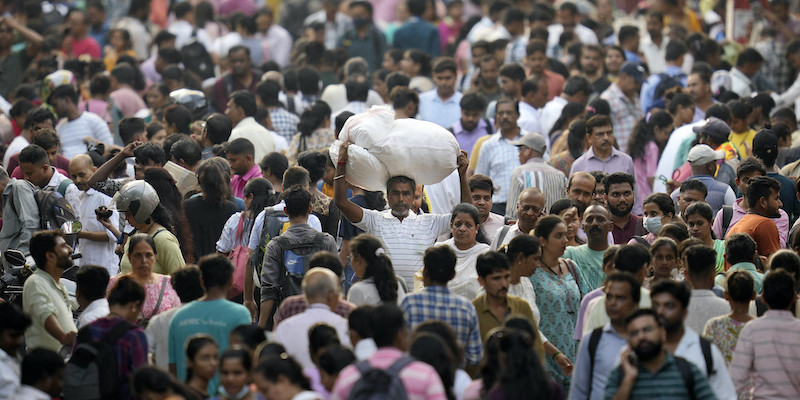Loading player
According to the most recent forecasts of the United Nations, in a few days India should become the most populous country in the world, thus overtaking China. The organisation’s economic and social affairs department has estimated that by the end of the month India’s population will be at least 1,425,775,850, slightly above that of China. Only a few days ago, however, another United Nations body, the United Nations Population Fundhad made a slightly different forecast, which had already been widely commented on and disseminated in the international and Italian media: based on that forecast, the overtaking should have taken place by the end of June, and not already in April.
The reason for the discrepancy between the two estimates is quite simple: in both cases, they are indeed estimates, not exact calculations. This kind of forecast is based on a series of data available to the organizations that deal with it: the starting one is provided by the last census carried out in the countries, and from there demographers make statistical calculations based on a series of parameters such as of fertility (ie the average number of children per woman), the trend of mortality and the trend of migrations. Naturally not everything is predictable, and for this reason the calculations on the overtaking of the Indian population over that of China have only become more precise in recent months, although they remain approximate.
Moreover, the data available for China and India are more incomplete than others: the most recent census in China took place in 2020, in India even in 2011. The ten-year census scheduled for 2021 has been postponed several times due to the pandemic and is now set for 2024. To calculate the current population of the two countries, the demographers therefore relied on administrative data on births and deaths: but in such large countries the margin of error is wide, and the indicators used for growth forecasts starting from those data can only provide estimates. A few days ago the head of the United Nations Department for Population Estimates and Projections, Patrick Gerland, had described to Associated Press their estimates as ‘a rough approximation, but the best possible’.
– Read also: The biggest cities in the world you never hear about
We will never know the precise day when the Indian population will have surpassed the Chinese one: indeed, as far as we know, it may have already happened. Only later, with the historical data available, can the moment of overtaking be established with greater precision.
The overtaking of the Indian population over that of China was in any case a widely expected and predicted event, but it was only recently that it was understood that it was about to happen, due to the rapid and unexpected drop in the fertility rate that affected China. It is a circumstance that well explains the difficulties of these calculations.
For decades in the twentieth century, the two countries experienced enormous demographic development and were forced to implement birth control policies, but these measures began to take effect in China well before they did in India. In 1971 the two countries had a very similar fertility rate, just under 6: this means that on average every woman in the country had almost 6 children in a lifetime. By the end of the 1970s, however, the fertility rate in China had already fallen below 3, while in India it fell below 3 only in the mid-2000s. Currently, an average of 1.2 children are born to every woman in China, while 2 are born in India.
It is estimated that China reached 1.426 billion inhabitants last year, and since then its population has stopped increasing: at the end of 2022 it had dropped for the first time in over 60 years, by 850,000 less than in last year. Instead, India’s population is expected to continue to increase for several more decades. In short, the gap is destined to grow: again according to United Nations estimates, in 2050 India will have more than 1.66 billion inhabitants, while China will have just over 1.3 billion.
– Read also: In India the beasts have a big problem
